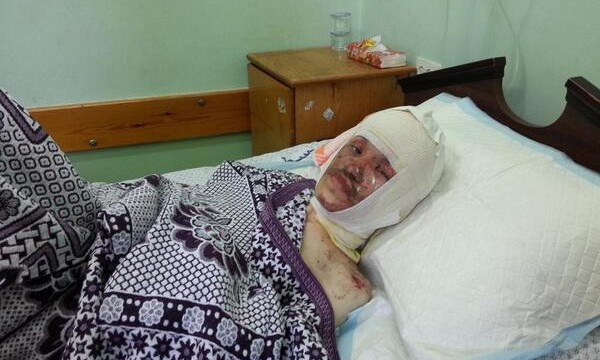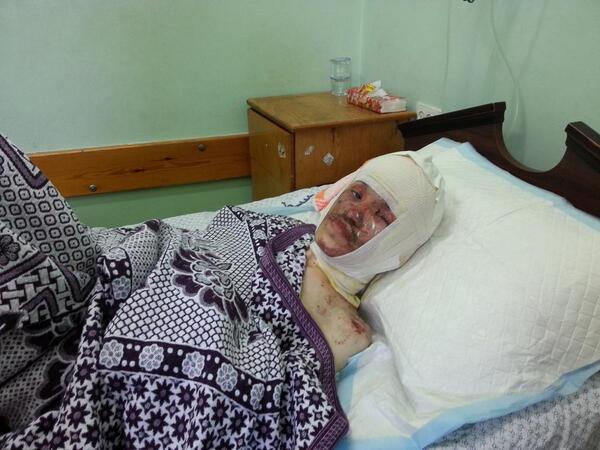Part II of a Feature Analysis on Palestine and ‘Operation Protective Edge’
by Tascha Shahriari-Parsa and Alon Lapid
Disability Centers, Water Facilities, Electricity Lines and Hospitals
One of the most outrageous Israeli airstrikes in Gaza was committed against a home for the disabled in Beit Lahiya, killing Ali Nabil Basal and Suha Abu Saade, who suffered from multiple disabilities. “How many of the people killed so far are civilians?” cries Youssef, Suha’s brother. “Even those they call terrorists, they are not terrorists; they are resistance.”
Another unconscionable strike hit a rehabilitation center for the disabled in Jabilaya, killing three patients and a nurse.

Thirty percent of his body was burned in an airstrike on a charity home for the disabled and 3 of his disabled friends got killed” says Belal, a Palestinian doctor living in Gaza.
A major water line and sewage plant, west of Gaza City, was also bombed a few days ago, a facility that provides more than 70,000 people with water and constitutes the principal water line for the al-Shati refugee camp in the Northern Gaza Strip, the third largest refugee camp in Palestine. “Israeli aircraft targeted a sewage plant west of the city, which serves the areas of al-Shati Camp, Tel al-Hawa neighborhood, Sheikh Ajlin, and the western areas of Gaza City,” stated the director of the Water Department in the Municipality of Gaza, Saad Eddin Al-Atbash. “[The sewage plant] pumps 25,000 cubic meters of wastewater daily to the public treatment plant.”
Israeli warplanes have also targeted two water wells and five water-lines, all located in vital areas where tens of thousands of people rely on them. A water crisis has been ongoing in Gaza since the beginning of the summer: the Gaza strip requires 180 million cubic meters of water per year, yet renewable sources fail to manage even half of that. “While the city is working on improving the water supply systems for the citizens in Gaza,” says Al-Atbash , “Israeli forces are working on the destruction of water wells in order to increase the suffering of the citizens during the summer.”
On Friday July 11, 75% of Gaza City was left without electricity after heavy Israeli strikes in the area, damaged two out of the city’s three electricity lines. Many lines throughout Gaza have been frequently damaged, repaired, and damaged again, including an electricity line from Rafah to Cairo that was damaged three times in the span of two days, at one point working for 30 minutes before being damaged again.
To add to the list of outrageous strikes, on July 17 at around 8pm, Israel repeatedly bombed the el-Wafa rehabilitation hospital , the only rehabilitation center in the Gaza strip. Patients and doctors were forced to evacuate after the hospital was targeted by airstrikes and artillery shells. “It’s already destroyed,” said Basman Alashi, director of el-Wafa. “I don’t know how much is left of it, but we have evacuated all of our patients. We lost power, there was a fire in the building.”
The UN fact-finding mission to Gaza has determined that the Israeli Defense Forces (IDF) practice a “deliberate policy of disproportionate force,” aimed at the “supporting infrastructure” of the enemy. After attacks on hospitals, centers for people with disabilities, and facilities that provide tens of thousands of people with water and electricity access, Israel has some serious questions to answer about their real motives behind this operation.
Palestinians Forced to Flee Northern Gaza
Thousands of Palestinians fled Northern Gaza on Sunday after Israel issued a warning to those in the region to leave their homes “for [their] own safety”, in anticipation of further airstrikes and what was then the potential threat of a ground invasion. Israel began by mobilizing 33,000 soldiers for a ground assault.
“They threatened us that if we do not leave our homes, they will destroy them with us in them,” said one fleeing Palestinian woman. “We were scared because they would do that and they can’t be trusted. They are unjust. They have no mercy. They do not differentiate between a child and a grown up .”
Thousands have sought refuge in schools run by the United Nations Relief and Work Agency for Palestine Refugees in the Near East (UNRWA), now transformed into temporary shelters for fleeing families. These schools, however, are severely overcrowded, and obviously not suited to the task of serving as impromptu refugee shelters for thousands of people. Gazans are justified in feeling afraid of the inhuman face of the Israeli war machine — a machine that robs families of their homes and ignores UN calls to avoid a ground invasion.
“We are here because of the attacks,” said a Palestinian man seeking refuge in a UNRWA school. “The aircrafts attack us every night. We can’t differentiate night from morning . The attacks are non stop with no mercy.”
The Ground Invasion Becomes Official
On Thursday, July 17, Israel’s ground invasion became official. The IDF began operating north near Beit Lahiya, and some were positioned in the east. “Our forces,” said Israel’s chief military spokesman Brig. Gen. Motti Almoz , “large ground forces accompanied by massive air force support, naval forces and intelligence, are taking over targets in Gaza.” Since then, heavy tank shelling has been reported. On Friday morning, Israel called in another 18,000 reservist troops to join the invasion.
The entire logic behind Israel’s “warning” to civilians is absurd. They warn Gazans that they’re going to invade, that they will be under fire; yet can Palestinians in the region even run away? Where are they supposed to go when the only borders around them are water, the closed border of Egypt, and the border of a country that they are not allowed to cross even though that country is occupying their land? There is no other way to describe it: Palestinians are trapped in a giant, lethal prison in the hands of Israel.
Mass Arrests
Since June 12th, the beginning of Israel’s mass campaign of arbitrary arrests, 1079 palestinians have been detained . This campaign was mainly resumed and expanded on July 14, when another 57 Palestinians were arrested, including Abdul-Sattar Qassem, an academic, and 11 members of the Palestinian Legislative Council (PLC) — reaching a total of 35 imprisoned PLC members.
Sammer Issawi is one of the many arbitrarily imprisoned Palestinians. A hunger striker, he has now been imprisoned twice, and so has his sister and lawyer Shireen Issawi. Disturbingly, what relates all of these prisoners to each other is the fact that they are being imprisoned without charge or trial .
The Ongoing Illegal Blockade of Gaza
Despite the fact that the Oslo Accord of 1993 guarantees Palestinians the right to freely travel and trade goods between Gaza and the West Bank, Israel has continued to prevent this legal reality from turning into an actual one. On occasion, such as between 2007 and 2010 , Israel has allowed only certain goods into the territory that it deemed to be “vital for the survival of the civilian population”. Arbitrary restrictions have been placed on such unnecessary items as shoes, paper, and even coffee and tea, which were banned from being imported into and exported out of the Gaza strip.
‘The Facade of Ceasefire Talks,’ Part III of this five-part series on Palestine and Israel’s ‘Operation Protective Edge’ is available here.
Comments

Pingback: Gaza, Gaza don’t you cry | BASICS Community News Service